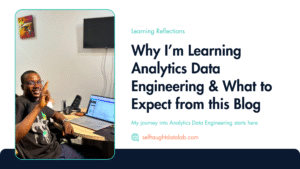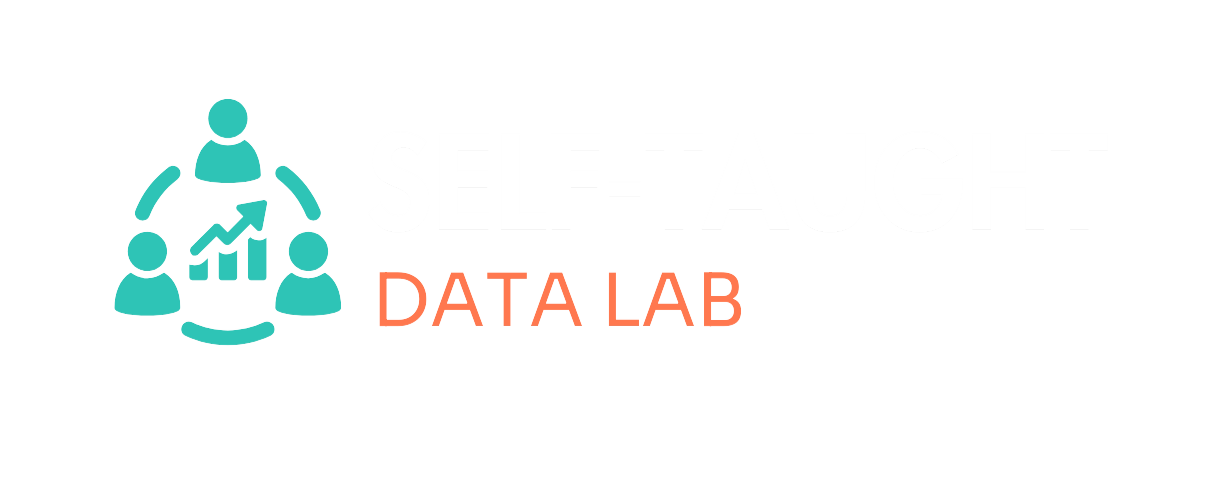Learn, Grow and Excel in Data & Analytics 🤝

Why I’m Learning Analytics Data Engineering & What to Expect Going Forward
How It All Started
I love everything about data, and I enjoy analyzing it.
Back in 2018, I started my journey in tech with Data Analytics, but my interest in data started long before that time. Before I even knew what “data analytics” meant, I had a friend (an MSc student at the time) who helped undergrad students analyze their project data. I’d always be around him, watching him work, and once in a while, he’d pass me some results to compute before he started interpreting the data.
My tasks were simple—mostly tabulating the results for him. But when he starts explaining the results, I see something fascinating. The numbers were not just mere figures; they actually told a story. The patterns started to make sense, and I began to see insights from different angles. Reading through the results became exciting because it felt like the real discoveries were hidden beneath the surface—at least, that’s what I thought. That experience sparked my interest and curiosity. I wanted to go beyond just helping him organize data—I wanted to analyze the data myself, uncover the insights, and truly understand what the numbers were saying.
By April of that year, I decided to learn how to analyze data. I had no structured learning plan, no mentor—just curiosity and my laptop. I started with Excel and SPSS, watching random YouTube tutorials and practicing on my own. In less than three months, I was already taking on student projects, cleaning and analyzing their data. Soon, I started getting paid tasks from final-year undergraduate students and even some lecturers in my faculty. The fact that I was making money from it was a huge motivation to keep going.
That’s how my journey into data analytics started.
Over the years, I kept expanding my skills, learning new tools like SQL, Power BI, and Python. I’ve explored and worked on projects with some popular Python libraries like Pandas, NumPy, Matplotlib, Seaborn, and Scikit-learn. Eventually, I even learned software development to complement my data analytics skills.
The Project That Inspired This Path
Late last year (2024), I got a contract from a researcher in epidemiology at one of the top U.S. universities to analyze a dataset for a public health conference presentation. I was excited, but when I got the dataset, I immediately knew this wasn’t going to be easy.
The data was a mess.
- Missing values everywhere
- Duplicate records that didn’t make sense
- Weird formatting
- Hundreds of thousands of rows with no clear structure
At first, I thought, “I’ll clean it in 30 minutes, no big deal.” But as I kept working on it, I realized my usual methods weren’t enough. I spent days trying to figure out the best approach for effective data cleaning.
I ended up using Python to write scripts to automate the cleaning process. That helped, but then came another challenge—the analysis itself. The project required applying weights and stratification, which wasn’t something I could easily do in Python. I tried using Python to apply weights to the dataset, but stratification wasn’t possible. I did some research and found that there was no available library in Python for stratified analysis.
That’s when I turned to SPSS to handle the complex statistical analysis. I spent hours figuring it out, but in the end, the job was done and the client was happy. I delivered the insights they needed, and the project was a success.
But for me, it was a wake-up call:
👉 I had always focused on analyzing data, but I didn’t really understand how raw data was processed before it got to me.
👉 Most real-world data is messy, and manual cleaning isn’t scalable.
👉 Automating data processes requires deeper technical skills.
That’s when I started thinking seriously about Analytics Data Engineering.
Why Analytics Data Engineering?
A lot of people think data analysts just open a clean dataset and start analyzing. At least, I thought that way when I was getting started. But in reality, most data is a complete mess!
I can’t even count how many times I’ve opened a dataset and thought, “What is this nonsense?” Missing values all over the place, duplicate records that don’t make sense, dates stored as text, numbers mixed with words—it’s frustrating. And honestly, sometimes cleaning the data takes more time than the actual analysis.
That’s when I started asking myself:
- Where does all this messy data even come from?
- How do companies handle massive amounts of raw data?
- What does it take to automate data processing instead of doing it manually every time?
The more I thought about it, the more I realized that I don’t just want to analyze data—I want to be part of the process that makes raw data usable.
That’s why I’m transitioning into Analytics Data Engineering. I want to learn how to design efficient data pipelines, automate data workflows, and bridge the gap between raw data and actionable insights.
This isn’t just another skill upgrade for me—it’s the next step in my career.
My Self-Taught Philosophy
I’ve always been a self-learner. But over the years, I’ve realized that a few core principles make the journey smoother. I believe that learning by doing beats passive consumption. And my approach is simple:
✅ Learn the fundamentals—I focus on understanding the core concepts before diving into tools.
✅ Build projects—The best way to learn is by applying what I know in practical, real-world scenarios.
✅ Break things & fix them—I learn the most when I make mistakes, troubleshoot, and figure things out.
✅ Share my journey—Teaching is the best way to solidify knowledge. Plus, if I can help someone avoid my mistakes, why not?
This series will be a raw, unfiltered documentation of my progress—not some polished highlight reel. I’ll share the wins, but also the struggles, the bugs that kept me up at night, and the “aha” moments that made it all worth it.
What You Can Expect in these Series
Starting today, I’ll be documenting my entire Analytics Data Engineering journey here at Self-Taught Data Lab—the wins, the struggles, and everything in between.
Here’s what you can expect:
- My step-by-step learning journey: What I’m learning, how I’m learning, and the challenges I’m facing.
- Hands-on projects: I’ll work with real datasets and share my approach.
- Breakthroughs & frustrations: I’ll share everything—the good, the bad, and the “why isn’t this working?!” experiences.
- Connecting the dots between DA & DE: I’ll be sharing my thoughts (from personal experiences) on why understanding both data analytics and data engineering makes you a stronger data professional.
By the way, I’m learning this from scratch—no bootcamps, no shortcuts. Just consistent, hands-on learning and sharing what I figure out along the way.
Let’s Learn Together!
🤔 Are you also exploring Data Engineering?
🤔 What’s been your biggest challenge so far?
Drop a comment, share your thoughts, or just follow along as I build in public.
Let’s do this, my friend! 😍


Your journey is truly inspiring, your ability to navigate challenges and keep growing is something I really admire.
Being your student has been the best decision in my data analytics journey.
Wow! So glad to hear about your next move.
Keep going, Chris—you’re truly an inspiration!
What an inspiring journey! 👏
What I’ve learnt from you is that there’s nothing that’s not learnable.
I will be waiting for more series
Thank you so much for being an inspiration